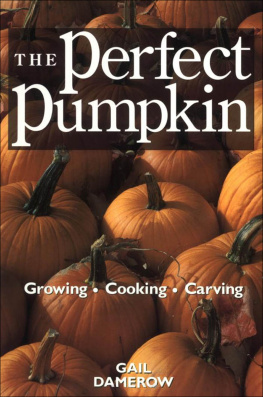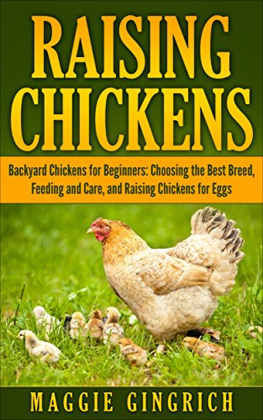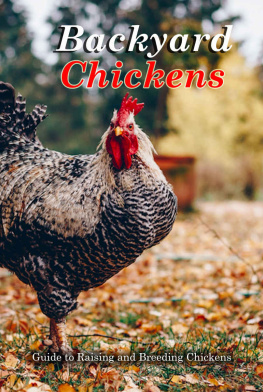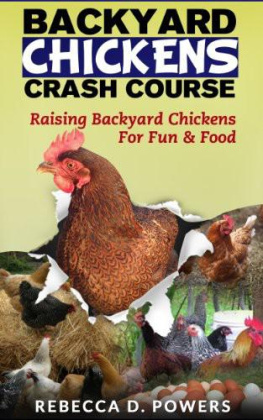Storeys Guide To Raising Chickens
Third Edition
Storeys Guide to
Raising Chickens
Care Feeding Facilities
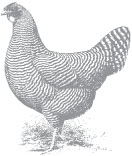
Gail Damerow

The mission of Storey Publishing is to serve our customers by publishing practical information that encourages personal independence in harmony with the environment.
Edited by Rebekah Boyd-Owens, Sarah Guare, and Deborah Burns
Art direction and book design by Cynthia N. McFarland
Cover design by Kent Lew
Text production by Erin Dawson
Cover photograph by Jason Houston of Billie Best's Silver Laced Wyandottes, Crazy Wife Farm
Interior photography and illustration credits appear on
Expert review by Ronald Kean
Indexed by Christine R. Lindemer, Boston Road Communications
2010, 1995 by Gail Damerow
Ebook version 1.1
September 9, 2015
All rights reserved. No part of this book may be reproduced without written permission from the publisher, except by a reviewer who may quote brief passages or reproduce illustrations in a review with appropriate credits; nor may any part of this book be reproduced, stored in a retrieval system, or transmitted in any form or by any means electronic, mechanical, photocopying, recording, or other without written permission from the publisher.
The information in this book is true and complete to the best of our knowledge. All recommendations are made without guarantee on the part of the author or Storey Publishing. The author and publisher disclaim any liability in connection with the use of this information.
Storey books are available for special premium and promotional uses and for customized editions. For further information, please call 1-800-793-9396.
Storey Publishing
210 MASS MoCA Way
North Adams, MA 01247
www.storey.com
LIBRARY OF CONGRESS CATALOGING-IN- PUBLICATION DATA
Damerow, Gail.
Storeys guide to raising chickens / by Gail Damerow. 3. ed.
p. cm.
Includes index.
ISBN 978-1-60342-469-1 (pbk. : alk. paper)
ISBN 978-1-60342-470-7 (hardcover : alk. paper)
1. Chickens. I. Title. II. Title: Guide to raising chickens.
SF487.D185 2010
636.5 dc22
2009045294

Preface
Chickens were on Earth long before humans and still have the same basic needs they always had food, protection, and procreation. Unlike the jungle fowl from which they derived, domesticated chickens have become dependent on humans to help fulfill those basic needs.
Over the millennia, different breeds were developed in different areas for different reasons. As a result, todays breeds range from those that are tiny enough to fit in the palm of your hand to those that are so tall they come nearly to your waist. Colors and patterns range from solid red, white, blue, or black to speckled, striped, and laced. The feathers might be long and thin, short and wide, or furlike and may appear not only on the chickens body but also on its feet like a pair of boots, down its legs like trousers, beneath its beak like a beard, on the sides of its beak like a mustache, or on top of its head like a fancy Easter bonnet.
Depending on the traits for which these various breeds were bred, some chickens are nearly self-sufficient foragers, while others squat by the trough waiting for the next meal. Some retain their innate sense of self-preservation; others dont have the sense to come in out of the rain. Some hens still have the instinct to collect eggs in a nest and hatch them into chicks; others have no interest in motherhood. Most cocks still mate the time-honored way, while a few breeds require human intervention in order to fertilize eggs to produce more of their kind.
Meanwhile, we humans have diverse needs and desires. Some of us want lots of tasty eggs; some want meaty chickens that grow large or fast or both large and fast; some enjoy nothing more than the beauty of brightly colored chickens frolicking in the sunshine; and some take pleasure in the simple companionship of these large, land-based birds.
Our various lifestyles enter into the equation of our relationship with chickens. Some of us live on farms with plenty of land for our chickens to freely roam and few neighbors for them to bother. Others live in crowded communities where chickens must be more closely tended to avoid offending neighbors or becoming a meal for a neighborhood pet.
All of this diversity among chickens and humans gives rise to an incredible diversity in our purposes for keeping chickens, how many we keep, the breeds we choose, and the methods by which we shelter and maintain them. For this reason, no one can tell you the one right way to raise chickens, or offer you an established blueprint for keeping your own flock. The best anyone can do is explain the needs of fowl, offer possibilities for fulfilling those needs, and let you pick and choose the options that best fit your particular situation.
And that is the goal of this book.
May your chicken-keeping decisions result in happy, healthy birds that fulfill their purpose in your life and bring you abundant joy.

1
Choosing a Breed
The fun of raising chickens begins right from the start, when you get to choose which color, shape, and size to have. With so many options to consider, you should have no trouble finding the perfect chicken one thats both picture-pretty and ideally suited to your purpose. Your reasons for keeping chickens will influence your list of breeds to consider, and within each breed, you will encounter differences among varieties and strains that may or may not suit your purposes.
Breeds
No one knows exactly how many chicken breeds exist in the world. A breed is a genetically pure line having a common origin, similar conformation and other identifying characteristics, and the ability to reliably produce offspring with the same conformation and characteristics.
The latest edition of the American Poultry Associations American Standard of Perfection describes and depicts the one-hundred-plus breeds currently recognized by the American Poultry Association ( apa ), a group that started out as the nations premier organization for the poultry industry but has since narrowed its focus to exhibition. The American Bantam Association ( aba ) publishes its own standard, which doesnt always agree with the apa Standard. Along with those listed in the two standards, other breeds are available in North America, and many more exist in the world. Storeys Illustrated Guide to Poultry Breeds offers color photographs and detailed descriptions of most breeds found in North America. (See the Recommended Reading list on for publishing information for all books referred to in this guide.)
All birds within a given breed share the same skin color, number of toes, carriage, and feathering. Skin color may be yellow, like the skin of Cornish, New Hampshires, and Wyandottes, or white, like that of Australorps, Orpingtons, and Sussex. Most breeds have four toes, but some, such as the Dorkings, Faverolles, and Houdans, have five. The carriage may be more horizontal, like a Plymouth Rocks, or more vertical, like the Shamos.
Next page

